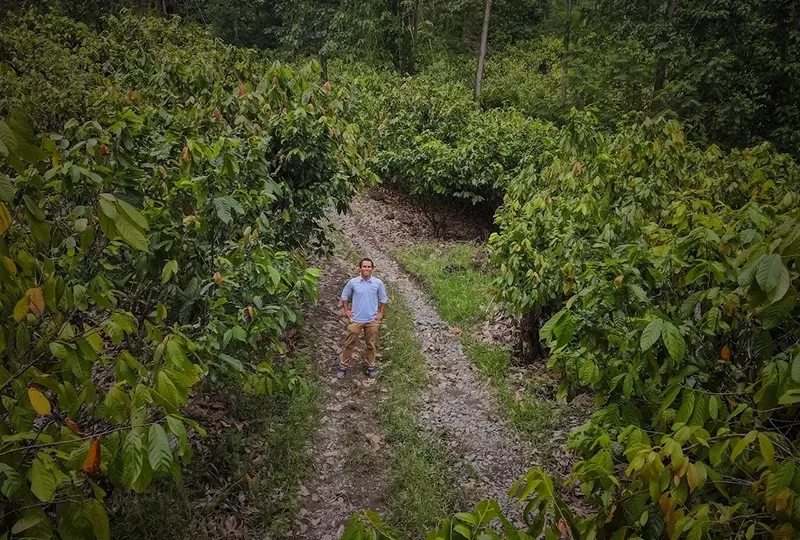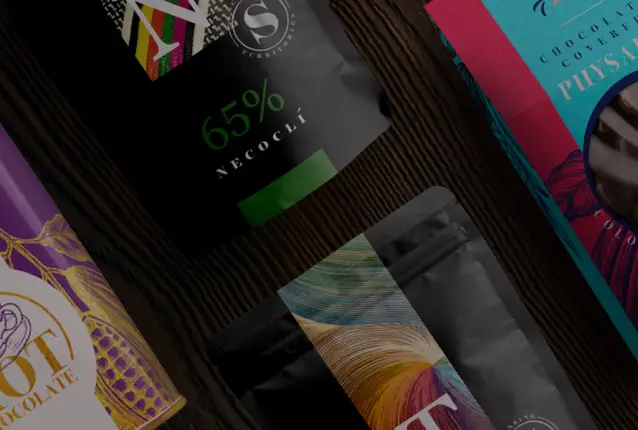| Key takeaway: Packaging decisions you make at the brief stage now determine your cost-to-serve, EPR fees, recyclability labels, and even market access in 2026–2030. |
For confectionery, the winning playbook is: mono-material where possible, recycled content where allowed, switching to PFAS-free barriers on packaging, clear on-pack disposal instructions, and local compliance by design.
A statistic to ground us: In the UK, flexible plastics account for 27% of consumer plastic packaging, but only around 7% is recycled, which is precisely why fees, labelling, and design guidance are being tightened to promote mono-material films and future kerbside collection.
What you’ll learn:
- What’s changing (and when) across the USA, Canada, Mexico, the UK, and the EU for confectionery packaging?
- The practical implications for standard formats (flow wraps, pouches, trays, cartons, and foil).
- How to design now to avoid red-flag fees, misleading labels, or relabel/rework later.
- A role-based checklist for faster approvals and fewer technical detours at launch.
Understanding packaging regulations for confectionery: a global snapshot for 2025
Quick Key insights:
- Design for recyclability is becoming enforceable, not optional (labels, fees, modulation, or outright restrictions).
- Flexible plastics (bars, pouches, pillow packs) are under a microscope. Markets are converging on mono-PE / mono-PP designs aligned to CEFLEX-style guidance, and scaling collection over 2025–2027. In the UK, that shift is formalised with a film & flexibles roadmap and timelines.
- Compostables are not a blanket solution. Guidance is to reserve them for specific use cases where they reach organics processing (e.g., caddy liners, contamination-prone foodservice formats)—and to avoid confusing recycling streams.
- Growing concerns about PFAS—often called ‘forever chemicals’—are leading many manufacturers of fibre-based food packaging to adopt safer, PFAS-free barriers. With several regions now restricting the intentional use of PFAS, industry groups like WRAP recommend avoiding these chemicals in compostable or fibre packaging.

Actionable tips
- Start component-level recyclability scoring during the concept phase—don’t wait for pre-press. In the UK, RAM (recyclability assessment methodology) is part of pEPR reporting and fee modulation.
- Default your flexible designs to mono-PE or mono-PP, and keep barrier layers within accepted thresholds where applicable (aim for “recycle-ready” in UK/EU, “Store Drop-off” or better in NA today).
- Treat compostable as a use-case tool, not the strategy. If used, certify (EN 13432 / ASTM D6400) and label for organics—not for recycling.
USA confectionery packaging regulations: Packaging EPR, recyclability claims & compostable standards (state-led, accelerating)
The United States addresses packaging regulation through a patchwork of state-level rules, rather than a single federal standard. That means your packaging might be acceptable in New York but flagged in California or Colorado. EPR frameworks are emerging across multiple states, while labelling and compostability rules are tightening. The key to growing confectionery brands? Design with the strictest state’s standards in mind so you can scale nationwide smoothly.

Key insights
- EPR laws are active in Maine, Oregon, Colorado, and California, with PRO enrollment and eco-modulated fees rolling out from 2025–2027. WRAP’s 2023 overview captures state timelines and the formation of the Circular Action Alliance (CAA) as the first multi-state PRO platform.
- Recyclability claims are tightening. California’s truth-in-labelling stance restricts the use of the chasing-arrows symbol when access/outcomes aren’t met; broadly, the FTC Green Guides require qualified claims if nationwide access isn’t substantial.
- PFAS bans in food packaging are proliferating at the state level (e.g., CA/NY/WA), impacting greaseproof fibre for confectionery.
- Compostables: Use ASTM D6400 (or D6868) certification, with clear “do not recycle” messaging when appropriate. WRAP’s compostables guidance reiterates the need for correct labelling and end-of-life routes to avoid contamination.
Actionable tips
- National SKU? Design to the most stringent state (e.g., CA) for recyclability claims and PFAS.
- Enrol with CAA (or applicable PRO) early to streamline multi-state EPR data and fees.
- Favour mono-material flexibles; target How2Recycle “Check Locally / Store Drop-off” at minimum for films today, with a roadmap to curbside acceptance where pilots scale.
Canada confectionery packaging regulations: Unified labelling (recyclable vs not), recycled content targets & federal plastics registry
Canada is building a cohesive national packaging strategy, harmonising federal rules (like recycled content and labelling) with evolving provincial EPR systems. The emphasis is on clarity—binary recyclability labels (“Recyclable” vs “Not Recyclable”) tied to real-world access. For confectionery brands, this means focusing early on ensuring actual recyclability and tracking compliance at the SKU level.

Key insights
- Canada is finalising federal rules to standardise recyclability/compostability labelling and phase in mandatory recycled content in plastics over 2026–2030. Labels are expected to be binary (“Recyclable”/“Not Recyclable”), tied to collection, sorting, and reprocessing thresholds of≥80%—driving design for real-world outcomes, not theoretical.
- Provinces operate EPR for packaging (Ontario, Québec, BC already mature), moving to full producer responsibility and harmonised data reporting via a Federal Plastics Registry (annual reporting of plastics placed on market).
- Compostables: certification plus clear on-pack guidance; “biodegradable” as a claim is being curtailed to avoid consumer confusion (aligns with WRAP cautions).
Actionable tips
- Build component-level recycle outcomes: if your flow-wrap can’t meet 80/80/80, plan to label “Not Recyclable” (and redesign for 2026–2030).
- Prioritise rPET in rigid applications (jars, thermoform trays) and PCR in PP/PE where food-contact approvals allow, to meet federal targets.
- Prepare bilingual (EN/FR) on-pack instructions and QR-linked detail pages to meet label specificity.
Mexico confectionery packaging regulations: LGPGIR, local SUP bans, and certified compostables in CDMX
Mexico’s approach combines federal waste laws with municipal-specific actions, particularly in places like Mexico City, which enforce compostable certification and implement bans on single-use plastics. As the country develops EPR frameworks, a proactive brand can win by ensuring packaging meets local standards and is ready for composting or recycling where infrastructure is available.

Key insights
- Mexico’s LGPGIR (General Waste Law) establishes extended producer responsibility and promotes a shift towards circularity; enforcement is increasingly state- and municipal-based, so local SUP bans and rules are significant (e.g., Mexico City).
- CDMX accepts only certified compostables (ASTM D6400 / EN 13432 / ISO 17088 / NMX equivalents) for certain single-use items, provided they are registered, labelled in Spanish, and accompanied by a waste plan to ensure the items reach the composting stage—setting a good precedent for any compostable confectionery component.
- Recycled content goals are under active development; many brands aim to achieve ~20–30% PCR in plastics by 2025–2030, aligning with federal direction and retailer expectations.
Actionable tips
- Validate city-level compliance before making pack-format commitments, especially for items such as sticks, straws, or novelty accessories.
- If using compostables in CDMX, certify, register, and label them, and plan the route to the organics infrastructure (including consumer instructions).
- Engage with ECOCE/industry schemes to support the collection of PET/HDPE when using rigid components.
UK confectionery packaging regulations: pEPR fees, RAM ratings, flexibles roadmap (to kerbside), and Plastic Packaging Tax
The UK now centres its packaging rules around the Extended Producer Responsibility (pEPR) framework, linking fees to your product’s recyclability score. Add to that a Plastic Packaging Tax (for plastics with less than 30% recycled content), and materials like flexibles are being driven toward mono-polyolefin models. The best strategy? Optimise design early for recyclability and cost-effectiveness.

Key insights
- The UK’s pEPR shifts full net household packaging costs to producers, with recyclability-based fee modulation via RAM (Red/Amber/Green) assessments. Compostable and “biodegradable” plastics currently trigger Red for plastics reprocessing, so use compostables only for proven organics pathways and label “do not recycle.”
- Plastic Packaging Tax (PPT) adds cost for plastic components with <30% recycled content—a strong incentive to lock in PCR where food-contact permits.
- The Film & Flexibles Roadmap outlines design, FOS collection scaling, and kerbside collection by March 2027, aligning with citizen messaging (bags & wrapping) and the design migration to mono-polyolefin structures.
Actionable tips
- Get every component RAM-rated early; design away from Red triggers (e.g., PVC, multilayer laminates with inseparable materials).
- Default to 30% PCR (or plan for it) in plastic trays/bottles/closures to reduce PPT exposure.
- Align flexible specs to mono-PE/PP now to be ready for 2027 kerbside and lower pEPR fees.
EU confectionery packaging regulations: PPWR (applies from Aug 2026), recyclability, recycled content & harmonised labels
The EU’s Packaging & Packaging Waste Regulation (PPWR) will bring uniform, legally binding requirements across the bloc—covering recyclability, recycled content, standardised labelling, and material bans. With deadlines ahead for 2026–2030, brands must act now to ensure their packaging is future-proof and compliant across all significant markets.

Key insights
- The Packaging & Packaging Waste Regulation (PPWR) is a directly applicable law (no transposition), with milestones for 2026–2030, including design for recyclability, recycled content in plastics, material-stream labelling, void-space limits, and tighter substance controls (e.g., PFAS constraints).
- Compostables are narrowly targeted to specific uses; the strategy emphasises recycling first, with CEFLEX-style mono-material designs for films.
Actionable tips
- Audit SKUs for non-recyclable formats (e.g., paper/plastic laminates, plastic/foil with inseparable layers) and develop a migration plan to mono-material formats.
- Prioritise rPET in rigid; pilot advanced recycled PE/PP for contact layers as approvals scale.
- Plan artwork zones for harmonised EU sorting/material icons, as well as QR codes for detail pages.
What works in packaging materials for chocolate & snacks?

Use this as your quick decision lens.
|
Material / Format |
Recyclability & Access |
Regulatory notes & watch-outs |
|
PET (bottles, jars, trays) |
Widely recycled; highest value stream. |
Enable rPET (UK PPT / EU PPWR / Canada targets). Avoid heavy tints; use wash-off labels. |
|
PP (pots, tubs, films) |
Rigid PP is widely accepted; films are improving. |
Favour mono-PP films; check local access (NA store drop-off vs UK/EU kerbside ramp). |
|
PE (films, bottles) |
HDPE rigid is strong; films moving from FOS to kerbside (UK 2027). |
Mono-PE flow-wraps for future-proofing; keep barrier layers within guidance. |
|
Multi-layer plastic/foil |
Generally not recyclable at scale. |
Phase out / redesign to mono-material ahead of EU 2030 recyclability expectations. |
|
Paper & paperboard |
Widely recycled. |
Use repulpable coatings; avoid heavy plastic lamination. Watch PFAS-free barriers. |
|
Plastic-lined paper |
Sometimes recyclable if thin coatings. |
If compostable, certify & label; ensure it won’t be misclassified as plastic. |
|
Aluminium foil (loose) |
Recyclable when balled together; tiny pieces can be lost. |
Consider format size; avoid inseparable plastic/foil laminates. |
|
Aluminium/steel tins |
Highly recyclable; suitable for gifting/reuse. |
Often lowest EPR fees are due to strong end-markets. |
|
Compostables (PLA, PHA, PBAT blends) |
Not recyclable with plastics; organics infrastructure is limited and variable. |
Reserve for specific, proven use cases; always ensure EN 13432/ASTM D6400 certification and label with “do not recycle.” |
|
Bio-based “drop-ins” (bio-PE/PET) |
Recyclable as their fossil equivalents. |
Good for carbon, doesn’t count as PCR; don’t market ambiguously as “biodegradable.” |
Actionable tips
- For bars and small formats, specify mono-PP or mono-PE films with minimal ink and approved barrier layers, targeting UK/EU flexible acceptance by 2027.
- For trays, prefer clear PET or PP, avoiding black carbon pigmentation; ensure labels and adhesives are recyclable-compatible.
- For cartons: keep coatings repulpable; specify PFAS-free barriers and document it.

Role-based takeaways & checklist for chocolate packaging regulations
R&D / Packaging Design
- Design for the strictest market you’ll ship into (CA/UK/EU are good “north stars”).
- Lock mono-material structures and PCR feasibility in early trials.
- Keep a recyclability matrix by component (film, sealant, label, ink, adhesive).
Regulatory Affairs
- Map your EPR registrations & data across USA states, UK, CA provinces, EU schemes.
- Maintain a live tracker of PFAS and other restricted substances; request supplier no-PFAS declarations for fibre and inks.
- For compostables: keep certificates (EN 13432 / ASTM D6400) and the exact label text on file.
Procurement
- Secure food-grade PCR for PET first; pilot advanced recycled PE/PP with converters.
- Add RAM/OPRL/How2Recycle compatibility and PFAS-free clauses to supplier specs.
- Budget for pEPR fees and PPT; use design choices to lower them.
Marketing / Product
- Avoid vague claims; use recognised labels and clear disposal instructions.
- Plan artwork space for country-specific symbols (EU harmonised labels, UK OPRL, CA icons).
- Use QR for localised “how to dispose” pages per market.
Final readiness checklist
- Each component has a recyclability outcome in each market.
- Labels match market rules (no chasing arrows where disallowed; compostables marked “do not recycle”).
- PCR targets are feasible and documented; PPT exposure is known.
- PFAS-free and heavy-metal-compliant declarations on file.
- Flexibles aligned to mono-polyolefin and UK/EU 2027 kerbside horizon.
Sources you can visit:
WRAP & UK Plastics Pact (evidence & guidance)
- WRAP – Considerations for Compostable Plastic Packaging (v1.1) (standards, labelling, PFAS note)
https://www.wrap.org.uk/resources/guide/compostable-plastic-packaging-guidance - WRAP – UK Plastics Pact Roadmap: Film & Flexible Packaging (version July 2024) (design, FOS → kerbside 2027)
https://wrap.org.uk/resources/report/uk-plastics-pact-roadmap-film-and-flexible - WRAP – USA Packaging EPR Fact Sheet (2023) (state EPR snapshot, CAA)
https://wrap.org.uk/resources/guide/usa-packaging-epr-guide
USA (officials & programs)
- Circular Action Alliance (US packaging PRO)
https://www.circulareconomyaction.org/ - California SB54 – Plastic Pollution Prevention and Packaging Producer Responsibility
https://leginfo.legislature.ca.gov/faces/billNavClient.xhtml?bill_id=202120220SB54 - Colorado HB22-1355 – Producer Responsibility Program for Recycling
https://leg.colorado.gov/bills/hb22-1355 - Oregon – Packaging EPR (SB582)
https://www.oregon.gov/deq/mm/production/Pages/PackagingEPR.aspx - Maine – Packaging EPR (LD1541)
https://www.maine.gov/dep/sustainability/materials/packaging-epr - How2Recycle (SPC)
https://how2recycle.info/
Canada (federal & provincial)
- Government of Canada – Single-Use Plastics Prohibition Regulations
https://www.canada.ca/en/environment-climate-change/services/managing-reducing-waste/reducing-plastic-waste/single-use-plastics-prohibition/regulations.html - Government of Canada – Federal Plastics Registry (overview)
https://www.canada.ca/en/environment-climate-change/services/managing-reducing-waste/reducing-plastic-waste/federal-plastics-registry.html - ECCC (Regulatory Framework on recycled content & labelling – background)
https://www.canada.ca/en/environment-climate-change/services/managing-reducing-waste/reducing-plastic-waste/labelling-rules-recycled-content.html - Circular Materials (Ontario PRO)
https://www.circularmaterials.ca/ - Éco Entreprises Québec (Québec PRO)
https://www.eeq.ca/en/
Mexico
- SEMARNAT – Ley General para la Prevención y Gestión Integral de los Residuos (LGPGIR)
https://www.gob.mx/semarnat/acciones-y-programas/ley-general-para-la-prevencion-y-gestion-integral-de-los-residuos - DOF – NOM-161-SEMARNAT-2011 (waste classification) https://www.dof.gob.mx/nota_detalle.php?codigo=5228046&fecha=01/02/2011
- Secretaría del Medio Ambiente (CDMX) – compostable plastics criteria/registration (Norma Ambiental) https://data.sedema.cdmx.gob.mx/portal/index.php/programas/ciudad-sin-plasticos
United Kingdom
- GOV.UK – Extended Producer Responsibility for Packaging (overview & guidance)
https://www.gov.uk/government/collections/packaging-waste-extended-producer-responsibility - GOV.UK – Plastic Packaging Tax (check if you need to pay)
https://www.gov.uk/guidance/check-if-you-need-to-pay-plastic-packaging-tax - OPRL – On-Pack Recycling Label
https://www.oprl.org.uk/
European Union
- European Commission – Packaging and Packaging Waste (PPWR / policy page)
https://environment.ec.europa.eu/topics/waste-and-recycling/packaging-waste_en - PPWR proposal (history and documents) https://environment.ec.europa.eu/publications/proposal-packaging-and-packaging-waste-regulation_en
- EN 13432 (compostability standard overview at CEN) https://standards.cen.eu/dyn/www/f?p=204:110:0::::FSP_PROJECT,FSP_ORG_ID:11325,6114





















